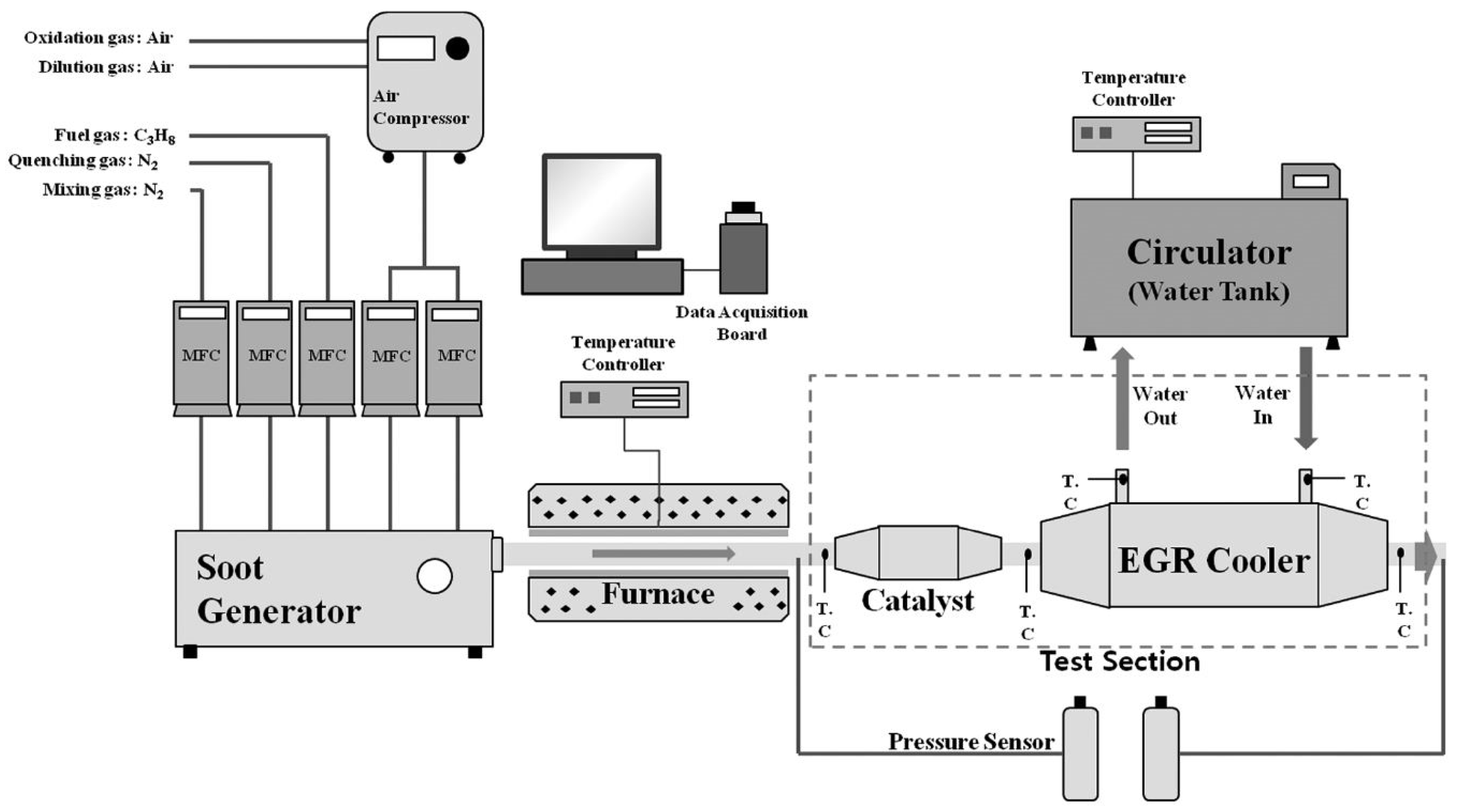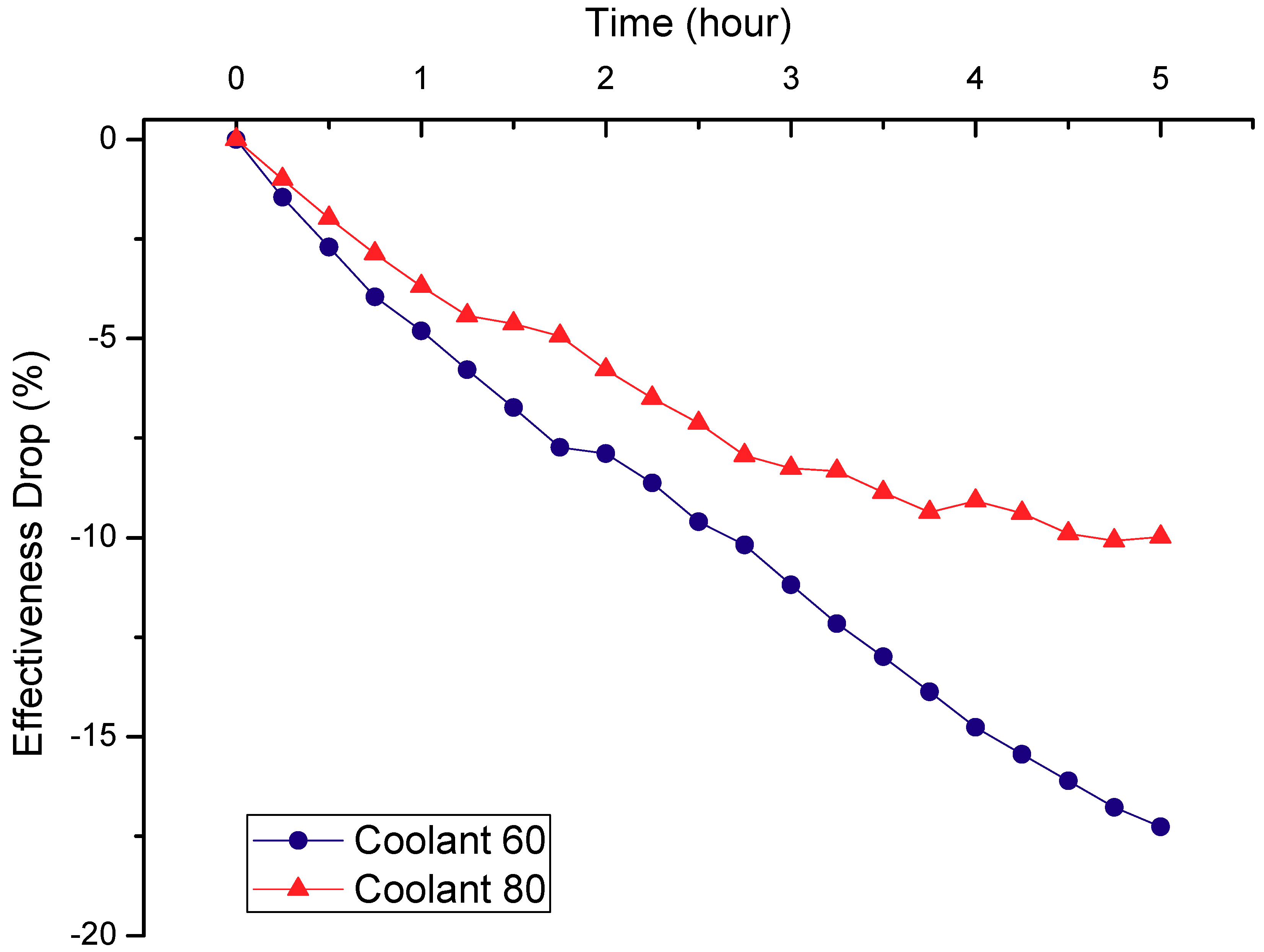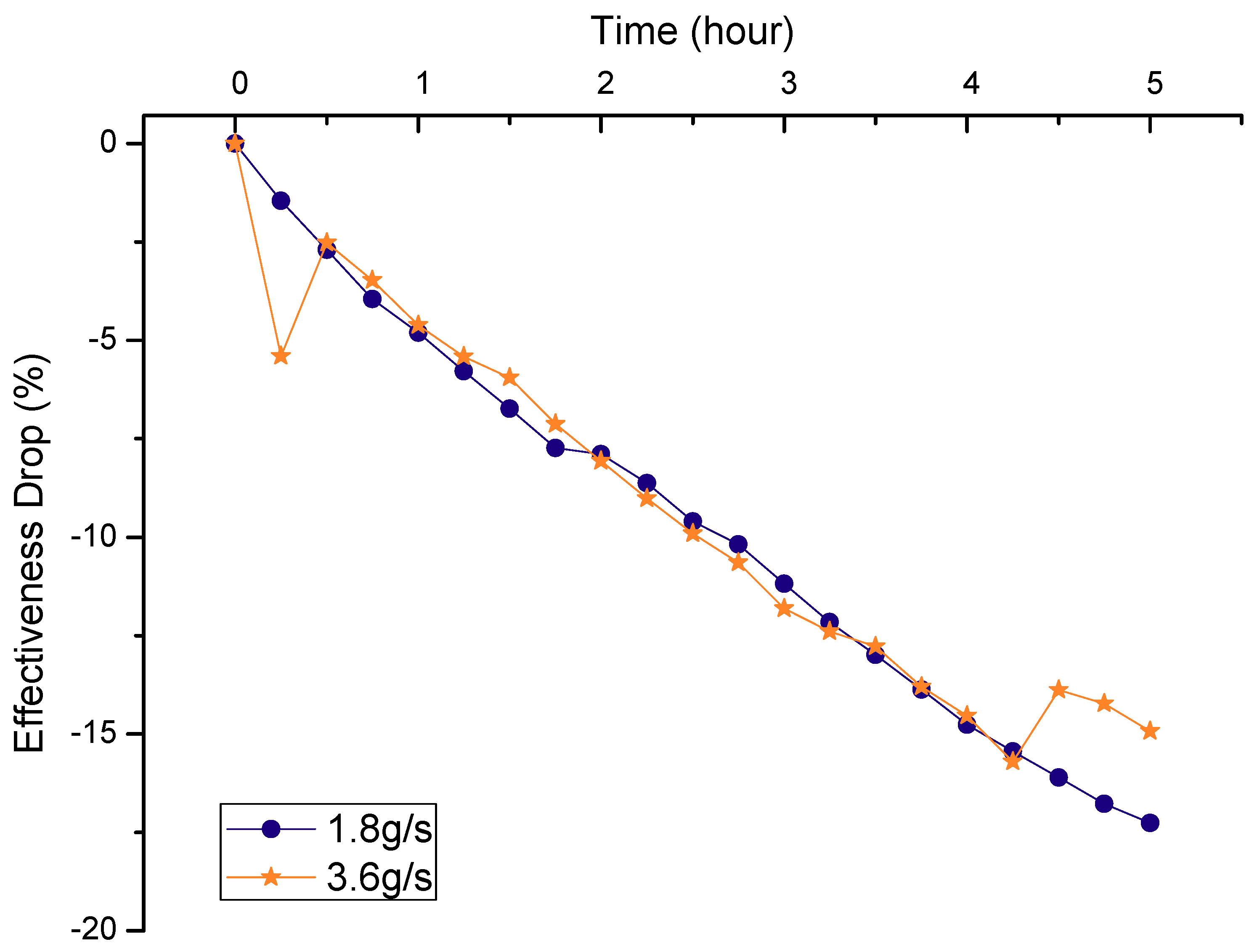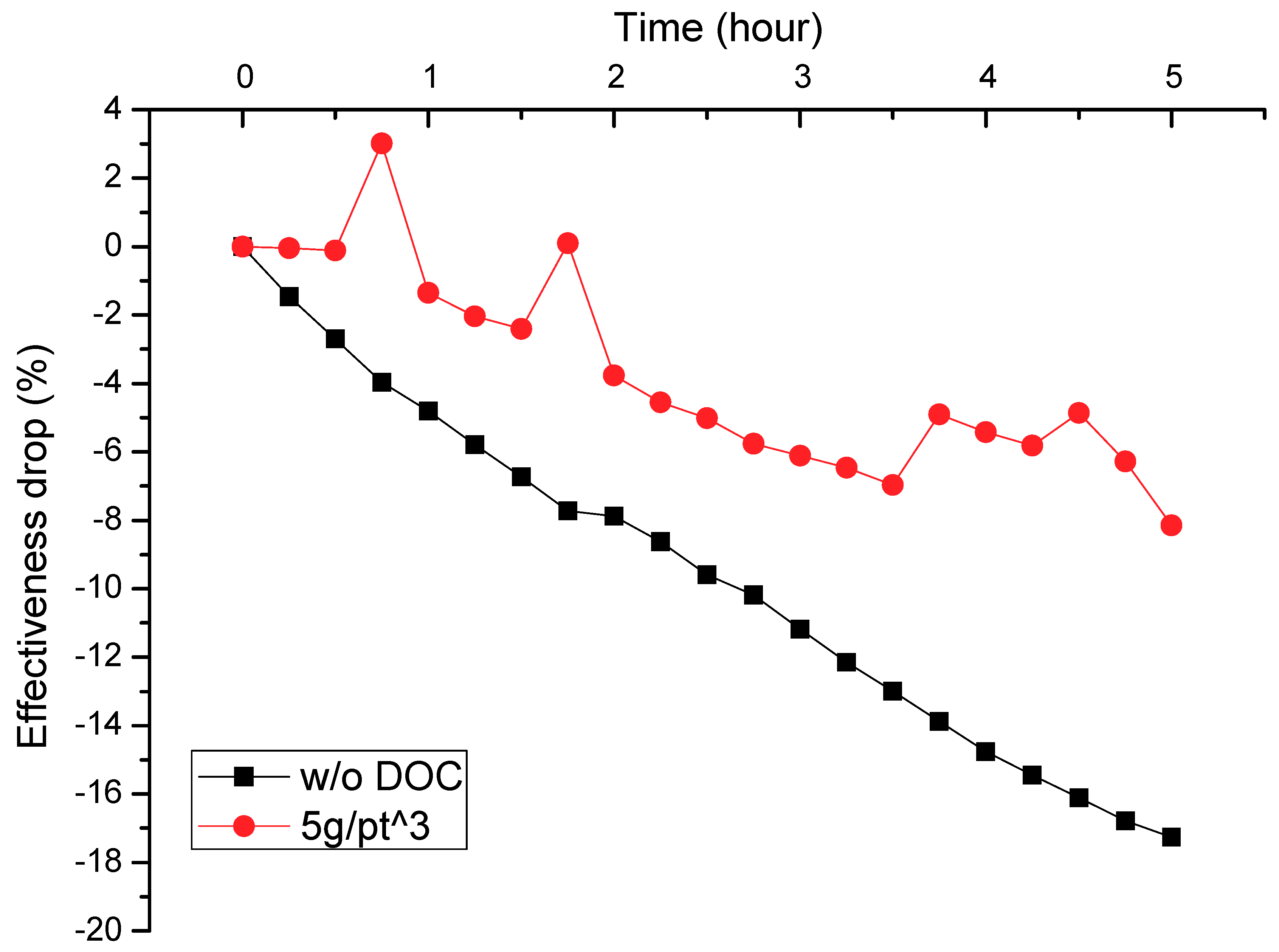Parametric Study on EGR Cooler Fouling Mechanism Using Model Gas and Light-Duty Diesel Engine Exhaust Gas
Abstract
:1. Introduction
2. Materials and Methods
2.1. Measurement Apparatus for Lab-Scale Experiments
2.2. Measurement Apparatus for Engine-Bench Experiments
- Flow control valve: In this experiment, the pipe of the exhaust gas was altered to allow by-pass in order to evaluate the EGR cooler fouling phenomenon using the exhaust partial flow from the engine. Flow control valves were installed in each pipe to control the flow rate. These valves could be used by connecting the compressor.
- Flow meter: A flow meter was set up at the rear of the cooler to measure the flow rate of the gas passing the test section. This device measured the flow rate by passing a current signal of 4–20 mA to the data acquisition board within the flow rate range of 1.5–150 g s−1.
- Cooling system: A device for controlling the temperature of the coolant entering the EGR cooler was set up separately to evaluate the effect of the coolant temperature on EGR cooler fouling. In the engine-bench experiment, it was difficult to maintain the temperature of the coolant entering the EGR cooler, unlike the case of the laboratory experiment, because in the former, exhaust gases pass the test section at high temperature and a high flow rate. Therefore, a radiator and fan were installed to maintain a constant coolant temperature.
2.3. Experimental Conditions
3. Results and Discussion
3.1. Effect of Coolant Temperature, Flow Rate and DOC Catalyst in the Lab-Scale Test
3.2. Effect of Coolant Temperature, Flow Rate and DOC Catalyst in the Engine-Bench Test
4. Conclusions
- The drop in the effectiveness of the EGR cooler was more pronounced when the coolant temperature was lower in both the laboratory and engine-bench experiments. This result proves that the fouling phenomenon was severe due to the temperature difference between the exhaust gas and wall of the cooler.
- In the lab-scale test, the effectiveness of the cooler declined to a greater extent at low flow rate than at high flow rate. This is attributed to the increase in the momentum of the particles for a constant number of particles. On the other hand, there was no effect of the flow rate in the engine-bench experiment, as the particle number increases when the flow rate of the exhaust gas increases. This suggests that the effects of increasing the flow rate and particle number could be de-coupled from each other in a real engine environment.
- In the engine-bench test, the heat exchange performance with the DOC catalyst upstream of the cooler was improved by about 9% due to the reduction in the soluble organic fraction of the PM after passing through the DOC. The results show that the DOC catalyst may be effective for improving the performance of the EGR cooler.
Author Contributions
Funding
Acknowledgments
Conflicts of Interest
Nomenclature
| BMEP | Brake mean effective pressure |
| CO | Carbon monoxide |
| CO2 | Carbon dioxide |
| DOC | Diesel oxidation catalytic converter |
| EGR | Exhaust gas recirculation |
| NOx | Nitric oxides |
| PM | Particulate matter |
| Pt | Platinum |
| THC | Total hydrocarbon |
References
- Walsh, M.P. Global trends in diesel emissions control. SAE Pap. 1997, 970179. [Google Scholar]
- Wade, W.R. Light-duty diesel NOx-HC-particulate trade-off studies. SAE Pap. 1980, 800335. [Google Scholar] [CrossRef]
- Zheng, M.; Reader, G.T.; Hawley, J.G. Diesel engine exhaust gas recirculation—A review on advanced and novel concepts. Energy Convers. Manag. 2004, 1145, 883–900. [Google Scholar] [CrossRef]
- Abd-Alla, G.H. Using exhaust gas recirculation in internal combustion engines: A review. Energy Convers. Manag. 2002, 43, 1027–1042. [Google Scholar] [CrossRef]
- Hoard, J.; Abarham, M.; Styles, D.; Giuliano, J.M.; Sluder, C.S.; Storey, J.M.E. Diesel EGR cooler fouling. SAE Int. J. Engines 2008, 1, 1234–1250. [Google Scholar] [CrossRef]
- Zhang, F.; Nieuwstadt, M. Adaptive EGR cooler pressure drop estimation. SAE Tech. Pap. 2008. [Google Scholar] [CrossRef]
- Maing, S.; Lee, K.S.; Song, S.; Chun, K.M.; Oh, B. Simulation of the EGR cooler fouling effect on NOx emission of a light duty diesel engine. Fall Conf. Proc. Korean Soc. Automot. Eng. 2007, 1, 214–220. [Google Scholar]
- Lance, M.J.; Sluder, C.S.; Wang, H.; Storey, J.M.E. Direct measurement of EGR cooler deposit thermal properties for improved understanding of cooler fouling. SAE Tech. Pap. 2009. [Google Scholar] [CrossRef]
- Grillot, J.M.; Icart, G. Fouling of a cylindrical probe and a finned tube bundle in a diesel exhaust environment. Exp. Therm. Fluid Sci 1997, 14, 442–457. [Google Scholar] [CrossRef]
- Bravo, Y.; Moreno, F.; Longo, O. Improved characterization of fouling in cooled EGR system. SAE Tech. Pap. 2007. [Google Scholar] [CrossRef]
- Usui., S.; Ito, K.; Kato, K. The effect of semi-circular micro riblets on the deposition of diesel exhaust particulate. SAE Tech. Pap. 2004. [Google Scholar] [CrossRef]
- Charles, F.L.R.; Ewing, D.; Becard, J.; Chang, J.S.; Cotton, J.S. Optimization of the exhaust mass flow rate and coolant temperature for exhaust gas recirculation (EGR) cooling devices used in diesel engines. SAE Tech. Pap. 2005. [Google Scholar] [CrossRef]
- Ismail, B.; Charles, F.; Ewing, D.; Cotton, J.S.; Chang, J.S. Mitigation of the diesel soot deposition effect on the exhaust gas recirculation (EGR) cooling devices for diesel engines. SAE Tech. Pap. 2005. [Google Scholar] [CrossRef]
- Bravo, Y.; Lazaro, J.L.; Garcia-Bernad, J.L. Study of fouling phenomena on EGR coolers due to soot deposits: Development of a representative test method. SAE Tech. Pap. 2005. [Google Scholar] [CrossRef]
- Hong, K.S.; Park, J.; Lee, K.S. Evaluation of catalyst assisted EGR cooler system for EGR cooler fouling reduction. Trans. KSAE 2011, 19, 76–81. [Google Scholar]







| Length (mm) | 350 |
| Inner diameter (mm) | 11.7 |
| Outer diameter (mm) | 12.7 |
| Thickness (mm) | 0.5 |
| Spiral | Non-spiral type |
| Material | ASTM 304 |
| Engine Type | Four Cylinders |
|---|---|
| Fuel-injection system | Common rail diesel |
| Bore × stroke | 83 mm × 92 mm |
| Displacement | 1991 cc |
| Maximum torque | 32.7 kgf·m/2000 rpm |
| Maximum power | 150 PS/4000 rpm |
| Compression ratio | 17.5 |
© 2018 by the authors. Licensee MDPI, Basel, Switzerland. This article is an open access article distributed under the terms and conditions of the Creative Commons Attribution (CC BY) license (http://creativecommons.org/licenses/by/4.0/).
Share and Cite
Park, S.; Lee, K.S.; Park, J. Parametric Study on EGR Cooler Fouling Mechanism Using Model Gas and Light-Duty Diesel Engine Exhaust Gas. Energies 2018, 11, 3161. https://doi.org/10.3390/en11113161
Park S, Lee KS, Park J. Parametric Study on EGR Cooler Fouling Mechanism Using Model Gas and Light-Duty Diesel Engine Exhaust Gas. Energies. 2018; 11(11):3161. https://doi.org/10.3390/en11113161
Chicago/Turabian StylePark, Sangjun, Kyo Seung Lee, and Jungsoo Park. 2018. "Parametric Study on EGR Cooler Fouling Mechanism Using Model Gas and Light-Duty Diesel Engine Exhaust Gas" Energies 11, no. 11: 3161. https://doi.org/10.3390/en11113161




